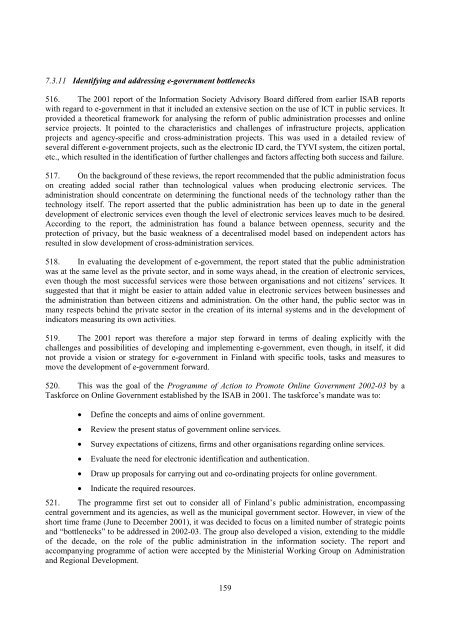e-GOVERNMENT IN FINLAND - ePractice.eu
e-GOVERNMENT IN FINLAND - ePractice.eu
e-GOVERNMENT IN FINLAND - ePractice.eu
You also want an ePaper? Increase the reach of your titles
YUMPU automatically turns print PDFs into web optimized ePapers that Google loves.
7.3.11 Identifying and addressing e-government bottlenecks<br />
516. The 2001 report of the Information Society Advisory Board differed from earlier ISAB reports<br />
with regard to e-government in that it included an extensive section on the use of ICT in public services. It<br />
provided a theoretical framework for analysing the reform of public administration processes and online<br />
service projects. It pointed to the characteristics and challenges of infrastructure projects, application<br />
projects and agency-specific and cross-administration projects. This was used in a detailed review of<br />
several different e-government projects, such as the electronic ID card, the TYVI system, the citizen portal,<br />
etc., which resulted in the identification of further challenges and factors affecting both success and failure.<br />
517. On the background of these reviews, the report recommended that the public administration focus<br />
on creating added social rather than technological values when producing electronic services. The<br />
administration should concentrate on determining the functional needs of the technology rather than the<br />
technology itself. The report asserted that the public administration has been up to date in the general<br />
development of electronic services even though the level of electronic services leaves much to be desired.<br />
According to the report, the administration has found a balance between openness, security and the<br />
protection of privacy, but the basic weakness of a decentralised model based on independent actors has<br />
resulted in slow development of cross-administration services.<br />
518. In evaluating the development of e-government, the report stated that the public administration<br />
was at the same level as the private sector, and in some ways ahead, in the creation of electronic services,<br />
even though the most successful services were those between organisations and not citizens’ services. It<br />
suggested that that it might be easier to attain added value in electronic services between businesses and<br />
the administration than between citizens and administration. On the other hand, the public sector was in<br />
many respects behind the private sector in the creation of its internal systems and in the development of<br />
indicators measuring its own activities.<br />
519. The 2001 report was therefore a major step forward in terms of dealing explicitly with the<br />
challenges and possibilities of developing and implementing e-government, even though, in itself, it did<br />
not provide a vision or strategy for e-government in Finland with specific tools, tasks and measures to<br />
move the development of e-government forward.<br />
520. This was the goal of the Programme of Action to Promote Online Government 2002-03 by a<br />
Taskforce on Online Government established by the ISAB in 2001. The taskforce’s mandate was to:<br />
x Define the concepts and aims of online government.<br />
x Review the present status of government online services.<br />
x Survey expectations of citizens, firms and other organisations regarding online services.<br />
x Evaluate the need for electronic identification and authentication.<br />
x Draw up proposals for carrying out and co-ordinating projects for online government.<br />
x Indicate the required resources.<br />
521. The programme first set out to consider all of Finland’s public administration, encompassing<br />
central government and its agencies, as well as the municipal government sector. However, in view of the<br />
short time frame (June to December 2001), it was decided to focus on a limited number of strategic points<br />
and “bottlenecks” to be addressed in 2002-03. The group also developed a vision, extending to the middle<br />
of the decade, on the role of the public administration in the information society. The report and<br />
accompanying programme of action were accepted by the Ministerial Working Group on Administration<br />
and Regional Development.<br />
159
















